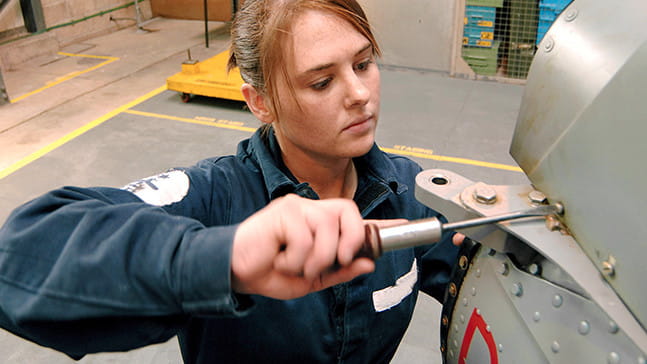Accelerated Apprentice scheme (Air Engineering)
You’ll be fast-tracked to working with our most advanced aircraft, as part of the team that maintains, services and inspects them.
High interest role
This is a highly competitive role with potential long lead time to join.
You may wish to consider joining the Royal Navy in one of these similar roles:
- £37,500 - £58,000
- A-Levels / college qualifications
- Fleet Air Arm
- Engineering
- Rating level
£37,711
£58,000
Level 3 Diploma Merit
Register
Study
6 weeks

The aircraft we work on is incredible. Being part of the team that keeps them in the air is so rewarding. It can be hard work at times, but solving a tricky problem is a great feeling.
Role details
What you’ll do
Joining the Royal Navy on the Accelerated Apprentice Scheme (Air Engineering) streamlines your route to working with our most advanced aircraft. You’ll receive condensed training, so you can quickly be part of the team that maintains, services and inspects the Fleet Air Arm’s helicopters and fighter jets.
Our aircraft can’t fly unless everything is safe – and that’s where you come in. Unlike comparable civilian roles, it won’t take long for you to take charge of some of the most sophisticated kit in existence, as you join as a Probationary Leading Hand – two ranks higher than most Engineering Technicians.
Your role
- Be a central part of the Royal Navy’s aviation capabilities, getting hands-on with our jets and helicopters, and making sure they can take off whenever they’re needed.
- Develop your engineering skills and specialise in mechanical technology and avionics. You’ll need to use all of your knowledge to find innovative solutions to complex problems, often under pressure.
- Serve on board a frigate, destroyer, aircraft carrier, at a Royal Naval Air Station (RNAS), or with a frontline squadron based overseas, looking after everything from the new F-35 Joint Strike Fighter to our Merlin helicopters.
- Maintain, service and inspect the Fleet Air Arm’s aircraft, working with your team before and after every flight, and operating at the highest levels of the engineering industry.
Pay & benefits
- A starting salary of £37,711, rising to £58,000 as your career progresses
- An excellent non-contributory pension scheme – we pay into it for you, so you don’t have to sacrifice any salary
- Six weeks of paid holiday every year – plus public holidays
- Free medical and dental care
- Amazing opportunities, including world travel and adventurous training for two weeks every year
- Free gym and sports, from football to kayaking to kite-surfing
- Forces Help to Buy scheme – a 0% loan to get you on, or further up, the housing ladder
- Subsidised travel, accommodation and food
- Handy discounts with lots of top brands, from Marriott hotels to Audi cars to high street stores
Skills for life
Qualifications you'll gain
- Certificate of Higher Education in Aeronautical Engineering
Opportunities open to you
- You could work toward a degree like Aeronautical Engineering
Skills you'll develop
- Use your natural aptitude for fixing things, on a massive scale. You’ll choose between rotary and fixed wing aircraft, developing all the specialist knowledge you need to become an engineering expert.
- Learn to maintain and operate some of the most cutting-edge kit on the planet.
- Work with interesting, sophisticated mechanical systems, like the F35 Joint Strike Fighter, and the Wildcat and Merlin helicopters.
Eligibility
- You need to be aged 17 to 25
- A minimum of three GCSEs (or equivalent) at grade 4 or above, including English Language, Mathematics and at least one science
- You must be a British or British Dual National, who has lived in the UK continuously for the 5 years prior to applying
- You need to be a minimum height of 145cm
- A Body Mass Index (BMI) between 18 and 28 (between 17 and 27 if under 18)
There are two options for acceptable vocational qualifications which are required in addition to the basic academic criteria above:
Option 1
- A National Qualifications Framework Level 3 Diploma (with a minimum of a Merit Pass) in an engineering discipline
Option 2
- At least 48 UCAS points in A-Levels (or equivalent) in Mathematics and a STEM subject (minimum grade D or above in each subject)
Skills & Interests
- A quick thinker, with a passion for working with the latest equipment and technology
- A problem-solver who can work well as part of a team
- An affinity for aircraft and avionics
- Enthusiasm for fixing and maintaining electronic and mechanical system
Joining Process
From picking your role to starting on your first day, these are the steps you'll take to join as a rating.
Submit an application
Defence Aptitude Assessment (DAA)
You’ll be tested on: Verbal Reasoning, Numerical Reasoning, Work Rate, Spatial Reasoning, Electrical Comprehension and Mechanical Comprehension.
To prepare, you can practise the DAA
Interview
Candidate Preparation Course (CPC)
Start training
Got a question?
Our virtual recruiter is available to answer your questions 24 hours a day
